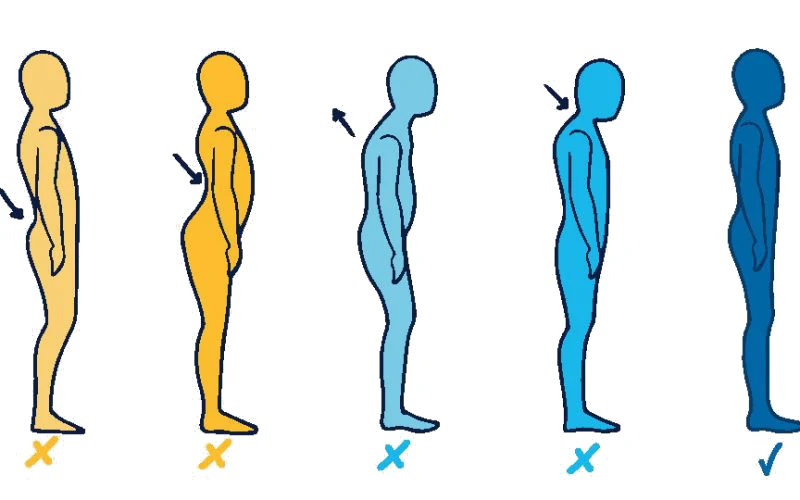How to improve your posture, Poor posture is a common issue that can lead to discomfort, pain, and long-term health problems.
Bad posture refers to a misalignment of different parts of the body in relation to gravity, leading to undue strain on muscles, ligaments, and joints. It is a prevalent issue in modern society due to long hours of sitting, using digital devices ( laptop and phone and tv..) .

What are the signs of bad posture?
- bad posture when sitting.
- Slouching or hunching forward.
- Muscle fatigue.
- lower back posture.
- posture while sleeping.
- Rounded shoulders.
- Poor balance and coordination.
- Head tilted forward.
- Development of a potbelly.
- Arching back leading to pain or other spinal issues.
How to improve your posture
- Awareness:
- Be mindful of your posture throughout the day. Regularly check in with your body to ensure proper alignment when sitting, standing, and walking.
- Ergonomic Workspace:
- Set up your workspace ergonomically. Adjust your chair, desk, and computer monitor to promote a neutral spine position. Your feet should be flat on the floor, and your knees and hips should be at right angles.
- Shoulder Blade Squeezes:
- Perform shoulder blade squeezes to strengthen the muscles between your shoulder blades. Sit or stand with your arms by your sides, then squeeze your shoulder blades together, hold for a few seconds, and release.
- Chin Tucks:
- Do chin tucks to strengthen the muscles in your neck. Sit or stand with a straight back, then gently tuck your chin in towards your chest without tilting your head forward. Hold for a few seconds and repeat.
- Back Extensions:
- Strengthen your lower back with back extension exercises. Lie face down and lift your upper body off the ground, keeping your neck in line with your spine. Hold for a few seconds and lower back down.
- Core Strengthening:
- Engage in core-strengthening exercises to support your spine. Planks, bridges, and abdominal exercises can help improve your core muscles, contributing to better posture.
- Stretching:
- Stretch tight muscles to increase flexibility. Focus on areas like the chest, shoulders, hip flexors, and hamstrings. Regular stretching can help open up tight areas that contribute to poor posture.
- Posture Exercises:
- Practice exercises that specifically target posture. For example, wall angels involve standing with your back against a wall and moving your arms up and down to strengthen the muscles responsible for good posture.
- Yoga or Pilates:
- Engage in activities like yoga or Pilates, which emphasize body awareness, core strength, and flexibility—important components of good posture.
- Regular Breaks:
- Take regular breaks if you have a sedentary job. Stand up, stretch, and move around at least once every hour.
- Footwear:
- Wear comfortable and supportive shoes to maintain proper alignment from your feet to your spine.
- Professional Assessment:
- Consider seeking guidance from a physical therapist or chiropractor. They can provide personalized assessments and exercises tailored to your specific posture issues.
How to fix an overbite Naturally at Home
Remember, improving posture is a gradual process, and consistency is key. Make these adjustments part of your daily routine, and over time, you may notice improvements in your posture and overall well-being. If you have existing health concerns or chronic pain, it’s advisable to consult with a healthcare professional for personalized advice.




